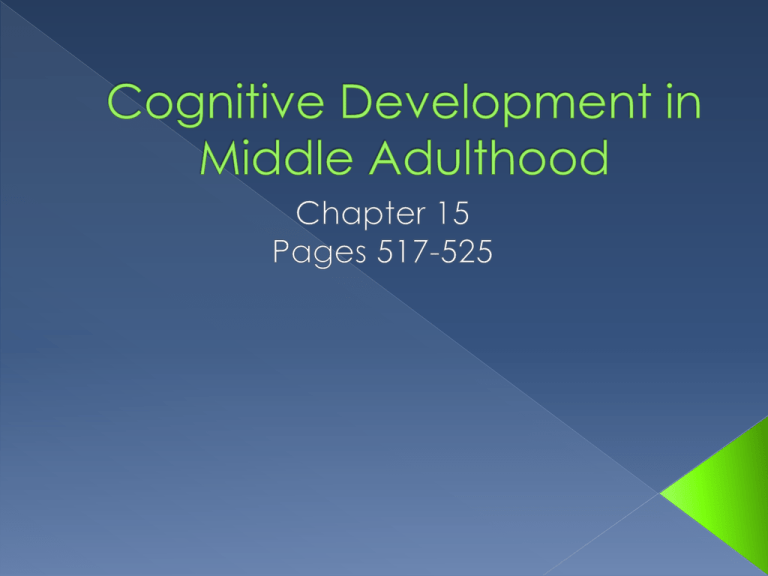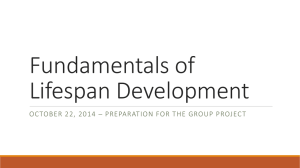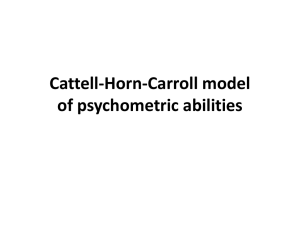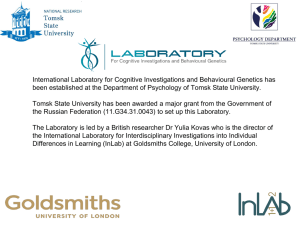Cognitive Development in Middle Adulthood
advertisement

In middle adulthood, the cognitive demands of everyday life extend to new and sometimes more challenging situations Middle adulthood is a time of expanding responsibilities – on the job, in the community, and at home To juggle diverse roles effectively middle aged adults call on a wide array of intellectual abilities › Including accumulated knowledge, verbal fluency, memory, rapid analysis of information, reasoning, problem solving, and expertise in their areas of specialization Widely held stereotypes exist of older adults as forgetful and confused › Most cognitive aging research has focused on deficits while neglecting cognitive stability and gains Different aspects of cognitive functioning show different patterns of change Although declines occur in some areas, most people display cognitive competence, especially in familiar contexts, and some attain outstanding accomplishment Some apparent decrements in cognitive aging result from weaknesses in the research itself › Overall, the evidence supports an optimistic view of adult cognitive potential Research on cognitive aging in middle adulthood reflects the core assumptions of the lifespan perspective › Development as multidimensional The combined result of biological, psychological, and social forces › Development as multidirectional The joint expression of growth and decline, with the precise mix varying across abilities and individuals › Development as plastic Open to change, depending on how a person’s biological and environmental history combines with current life conditions Research using intelligence tests sheds light on the widely held belief that intelligence inevitably declines in middle and late adulthood and the brain deteriorates Although many early cross-sectional studies showed a peak in performance at age 35 followed by a steep drop into old age › To explain this contradiction, K. Warner Schaie used a sequential design, combining longitudinal and cross-sectional approaches › › › BUT… Longitudinal research starting in the 1920s revealed an age-related INCREASE in performance Seattle Longitudinal Study In 1956, people ranging in age from 22-70 were tested cross-sectionally Then, at regular intervals, longitudinal follow-ups were conducted and new samples added, yielding a total of 5,000 participants, 5 crosssectional comparisons, and longitudinal data spanning more than 60 years Results Findings on 5 mental abilities showed the typical cross-sectional drop after the mid-30s › But longitudinal trends for those abilities revealed modest gains in midlife, sustained into the 50s and the early 60s, after which performance decreased gradually › Cohort effects are largely responsible for this difference In cross-sectional research, each new generation experienced better health and education than the one before it › Also, the tests given may tap abilities less often used by older individuals whose lives no longer require that they learn information for its own sake but, instead, skillfully solve real-world problems › Only certain mental abilities follow the longitudinal pattern in the previous chart There are 2 types of intelligence that seem to explain these findings › Crystallized intelligence – skills that depend on accumulated knowledge and experience, good judgment, and mastery of social conventions Largely influenced by culture Measured on intelligence tests by performance on vocabulary, general information, verbal comprehension, and logical reasoning › Fluid intelligence – depends more heavily on basic informationprocessing skills – ability to detect relationships among visual stimuli, speed of analyzing information, and capacity of working memory Measured on intelligence tests by items involving spatial visualization, digit span, letter-number sequencing, and symbol search Crystallized intelligence increases steadily through middle adulthood Fluid intelligence begins to decline in the 20s These trends have been found repeatedly in investigations in which younger and older participants had similar education and general health, largely correcting for cohort effects In one study of 16-85 year olds › Verbal (crystallized) IQ peaked between ages 45-54 and did not decline until the 80s › Nonverbal (fluid) IQ dropped steadily over the entire age range The midlife rise in crystallized abilities makes sense › Adults are constantly adding to their knowledge and skills at work, at home, and in leisure activities Schaie found that there are 5 factors that gain in early and middle adulthood: verbal ability, inductive reasoning, verbal memory, spatial orientation, and numeric ability › These factors include both crystallized and fluid skills Findings confirmed that middle-aged adults are intellectually “in their prime” A 6th ability, perceptual speed, a fluid skill decreased from the 20s to the late 80s › A pattern that fits with research indicating that cognitive processing slows as people get older Late in life, fluid factors (spatial orientation, numeric ability, and perceptual speed) show greater decrements than crystallized factors (verbal ability, inductive reasoning, and verbal memory) Mean Standardized Score 70 60 50 verbal ability 40 inductive reasoning 30 spatial orientation verbal memory numeric ability 20 perceptual speed 10 0 25 32 39 46 53 60 67 74 81 88 Age in Years Some theorists believe that a general slowing of central nervous system functioning underlies nearly all age-related declines in cognitive performance Many studies show that scores on speeded tasks mirror the regular, age-related decline in fluid-task performance Reasons why fluid intelligence (basic information processing skills) declines earlier, but crystallized abilities gain and then stabilize The decrease in basic processing, while substantial after age 45, may not be great enough to affect many well-practiced performances until quite late in life › Adults can often compensate for cognitive limitations by drawing on their cognitive strengths › As people discover that they are no longer as good as they once were at certain tasks, they accommodate, shifting to activities that depend less on cognitive efficiency and more on accumulated knowledge › Ex. The basketball player becomes a coach and the once quickwitted salesperson becomes a manager The age trends mask large individual differences Adults who use their intellectual skills seem to maintain them longer › In the Seattle study, declines were delayed for people with above-average education, complex occupations, and stimulating leisure activities that included reading, traveling, attending cultural events, and participating in clubs and professional organizations i.e. if you don’t use it you lose it People with flexible personalities, lasting marriages (especially to a cognitively high-functioning partner), and absence of cardiovascular and other chronic diseases were likely to maintain mental abilities well into late adulthood › i.e., individuals who experience less stress tend to sustain cognitive abilities longer › Probably because SES is associated with many of the stressful factors mentioned above Being economically well-off is linked to favorable cognitive development In early and middle adulthood, women outperformed men on verbal tasks and perceptual speed, while men excelled at spatial skills › However, overall, changes in mental abilities over the adult years were similar for men and women Cohort effects were evident in comparisons of baby boomers, now middle-aged, with the previous generation at the same age › On verbal memory, inductive reasoning, and spatial orientation, the baby boom cohort performed substantially better probably because of generational advances in education, technology, environmental stimulation, and health care › These gains are expected to continue: Today’s children, adolescents, and adults of all ages attain substantially higher mental test scores than same-age individuals born just a decade or two earlier Adults who maintained higher levels of perceptual speed tended to be advantaged in other cognitive capacities › Probably because thinking faster allows you to consider more things in a shorter period of time Information-processing researchers interested in adult development usually use this model to guide research on different aspects of thinking (we went over it in chapter 5) As processing speed slows, certain aspects of attention and memory decline › Yet, midlife is also a time of great expansion in cognitive competence as adults apply their vast knowledge and life experiences to problem solving in the everyday world On both simple reaction-time tasks (pushing a butting in response to a light) and complex reaction-time tasks (pushing a left-hand button to a blue light and a right-hand button to a yellow light), response time increases steadily from the early 20s into the 90s (meaning reaction takes longer) › The more complex the situation, the more disadvantaged (slower) older adults are Researchers agree that changes in the brain cause this agerelated slowing of cognitive processing, but disagree on the precise explanation › Neural network view – as neurons in the brain die, breaks in neural networks occur The brain adapts by forming bypasses – new synaptic connections that go around the breaks but are less efficient › Information-loss view – suggests that older adults experience greater loss of information as it moves through the cognitive system As a result, the whole system must slow down to inspect and interpret the information Ex. Imagine making a photocopy, then using it to make another copy, each subsequent copy is less clear Similarly, with each step of thinking, information degrades, the older the adult, the more exaggerated this effect Processing speed predicts adults’ performance on many tests of complex abilities The slower their reaction time, the lower their scores on memory, reasoning, and problem-solving tasks › Relationships are greater for fluid than crystallized-ability items › This suggests that processing speed contributes broadly to declines in cognitive functioning › The correlation between processing speed and other cognitive performances strengthens with age, but the correlation is only moderate Processing speed is not the only major predictor of age-related cognitive changes › Declines in vision and hearing and attentional resources, inhibition, working-memory, capacity, and use of memory strategies also predict diverse age-related cognitive performances Processing speed is a weak predictor of the skill with which older adults perform complex, familiar tasks in everyday life › Which they continue to do with considerable proficiency Studies of attention focus on: How much information adults can take into their mental systems at once The extent to which they can attend selectively, ignoring irrelevant information › The ease with which they can adapt their attention, switching from one task to another as the situation demands › › Research reveals that sustaining 2 complex tasks at once becomes more challenging with age › This may be due to the slowdown in information processing speed, which limits the amount of information a person can attend to at once As adults get older, inhibition – resistance to interference from irrelevant information – is also harder › Which can cause older adults to appear distractible in everyday life People who are highly experienced in attending to critical information and performing several tasks at once, such as air traffic controllers and pilots, show smaller age-related attentional declines Practice can improve older adults’ ability to divide attention between 2 tasks, selectively focus on relevant information, and switch back and forth between mental operations From the 20s into the 60s, the amount of information people can retain in working memory diminishes › Largely because of a decline in use of memory strategies Older individuals rehearse less than younger individuals – thought to be due to slower rate of thinking Older people cannot repeat new information to themselves as quickly as younger people › Reduced working memory capacity is another likely influence Leading to difficulties in retaining to-be-remembered items and processing them at the same time Memory strategies of organization and elaboration, which require people to link incoming information with already stored information, are also applied less often and less effectively with age › Older adults find it harder to retrieve information from long-term memory that would help them recall Tasks can be designed to help older people compensate for age-related declines in working memory › Ex. By slowing the pace at which information is presented or cueing the link between new and previously stored information To understand memory development and other aspects of cognition in adulthood, we must view them in context › Assessment in highly structured conditions may substantially underestimate what older adults remember when they can pace their own learning › General factual knowledge (such as historical events), procedural knowledge ( such as how to drive a car or solve a math problem), and knowledge related to one’s occupation either remain unchanged or increase into midlife › Aging has little impact on metacognitive knowledge, which middle-aged people use to maximize performance Ex. Reviewing major points before an important presentation, organizing notes and files so information can be found quickly, and parking the car in the same area of the parking lot each day In middle adulthood, gains in expertise occur › Expertise – an extensive, highly organized, and integrated knowledge base that can be used to support a high level of performance Gains in expertise support middle-aged adults’ continued cognitive growth in practical problem solving – analyzing how to achieve goals in real-world situations involving a high degree of uncertainty Expertise is seen in individuals in all types of work, not just in those who are highly educated or work in high-level jobs › Expertise can develop in any area in any field Age related advantages are also evident in solutions to everyday problems From middle age on, adults place greater emphasis on thinking through a practical problem – trying to understand it better, interpreting it from different perspectives, and solving it through logical analysis › Middle-aged and older adults select problem-solving strategies that are at least as good as and sometimes better than those of young adults › Creative accomplishment tends to peak in the late 30s and early 40s and then decline, but with considerable variation across individuals and disciplines The quality of creativity may change with advancing age in at least 3 ways › Youthful creativity is often spontaneous and intensely emotional While creative works produced after age 40 often appear more deliberately thoughtful › With age, many creators shift from generating unusual products to combining extensive knowledge and experience into unique ways of thinking › Creativity in middle adulthood frequently reflects a transition from a largely egocentric concern with selfexpression to more altruistic goals aimed at helping society as a whole Cognitive gains in middle adulthood are especially likely in areas involving experience-based buildup and transformation of knowledge and skills › When given challenging real-world problems related to their area of expertise, middle-aged adults are likely to out perform younger adults in both efficiency and excellence of thinking By middle adulthood, thinking is characterized by an increase in specialization as people branch out in various directions in their life paths To reach their cognitive potential, adults must have opportunities for continued growth › In occupation, leisure activities, and other aspects of their personal lives






